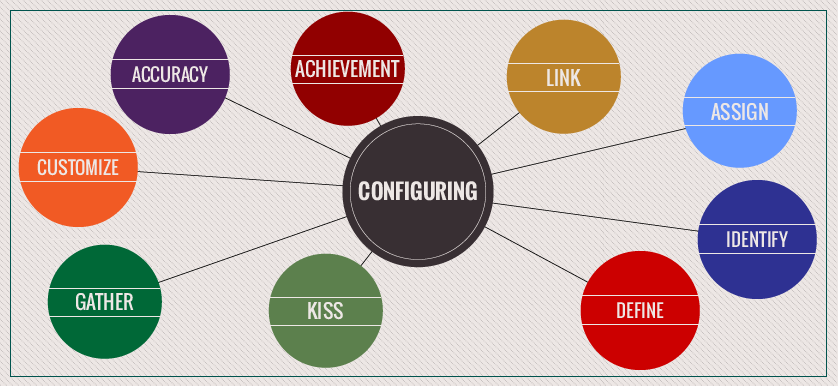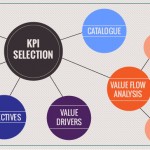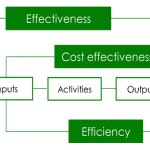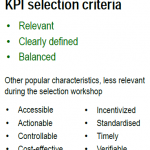15 bits of advice on KPI documentation and configuration
When we talk about configuring KPIs,what we mean is that after you select the ones you think are right, you create a comprehensive documentation of each and every relevant set of details for each KPI and activate them, so that the data these indicators collect will be easily reported on and analyzed.
In order to get a grasp on how the processes of KPI documentation and configuration work, we have 15 tips for you to keep in mind at all times.
1. Link KPIs – upstream with business objectives and downstream with organizational initiatives.
KPIs should be connected to organizational objective as they make objectives SMART. Initiatives should be establish to support the achievement of objectives by improving KPI results.
2. Assign a data custodian – an individual in charge of KPI data gathering.
Data gathering for each KPI requires clarity and ownership. Having a person in charge of collecting KPI data is a management approach which banks on maximizing accountability, whilst ensuring that data is available for analysis on time.
3. Assign a KPI owner – he will be responsible for the achievement of the desired results.
Each KPI should have a manager allocated as its owner, to ensure responsibility regarding its analysis, results and improvement options.
4. Avoid tunneling on KPI definitions – repeating the KPI name in the definition doesn’t add value.
Good practice in working with KPIs requires thorough documentation of what they represent. Proper KPI definitions should go beyond repeating the KPI’s name, by providing a simple explanation of what the KPI is about.
5. Categorize KPIs by their reporting status – active = data is tracked, inactive = data not available.
Activating KPIs is the process of moving a KPI status from inactive, when data is not available, to active – when data can be reported and a clear process is in place for doing so, on a regular basis.

6. Clearly identify the unit type – most of the time % (percentage), # (number) and $ (dollar value).
Given that KPIs are measurable items, they have an associated unit type. To simplify communication, the symbols showcased above should be used instead of the word expressing it, each according to its respective type.
7. Data accuracy for each KPI should be evaluated & treated as such – low, medium and high.
Not all KPIs have the same data reliability. Survey-based KPIs are always going to be less reliable than revenue KPIs, due to objectivity issues. Other aspects to be considered are data automation and auditing.
8. Determine the frequency of data generation and reporting for each KPI.
Data for some KPIs, such as ‘# Website visits‘ can be easily gathered on a daily basis. For other KPIs, such as ‘% Employee engagement‘, data gathering requires considerable costs and efforts, impacting a large number of staff. The frequency of reporting is influenced by factors such as cost, efforts and technical complexity.
8. Develop a customized KPI documentation form – it must contain all the relevant details describing the KPI.
Documenting KPIs can be easily done in a template that structures the main description fields considered relevant for the organization. smartKPIs.com contains such a model that can be customized at the organizational level.
10. Document if the trend is good – check for variances when increasing, decreasing or when data is within range.
For some KPIs, the results are good when they decrease from a period to another – for example ‘# Customer complaints’. For others, such as ‘$ Revenues‘, the results are good when they increase, while in the case of ‘% Budget variance‘, the results are good when within a specific range.

11. Document the reporting data for each KPI – where it is sourced from and who produces it.
Understanding a KPI relies on having a clear understanding of the data behind it and its source.
12. Don’t worry too much about leading or lagging KPIs – differentiating between the two is debatable and confusing.
What is considered a leading KPI for some, is a lagging KPI for others. As agreement around this differentiation is oftentimes difficult to achieve, it is secondary in importance and impact.
13. Ensure each KPI is clearly explained in a definition and has a purpose for usage.
The separation between definition and purpose is essential. The purpose expresses the reason for using the KPI and is one of the key components of the documentation form.
14. KISS – keep it short and simple – use the # and % symbol to replace “number” and “percentage” in KPI names.
Standardizing KPI names and shortening them supports communication and enables clear KPI data visualization in dashboard and scorecards.
15. Simplify KPI names by eliminating the word “of” – it is known as a common denominator, therefore it can be cut from the name.
KPIs are analytical in nature and where possible, their names should be as concise as possible. Definitions, calculations and purpose fields provide context and can be more wordy.
If you are interested in learning more about KPIs, smartKPIs.com subscriptions provide access to +500 KPI examples. Our dedicated Library contains relevant resources to improve your KPI practices, and if you want to further improve your knowledge, feel free to explore any of our latest publications at marketplace.kpiinstitute.org.
Image sources:

Tags: KPI, KPI Documentation, KPI Selection





